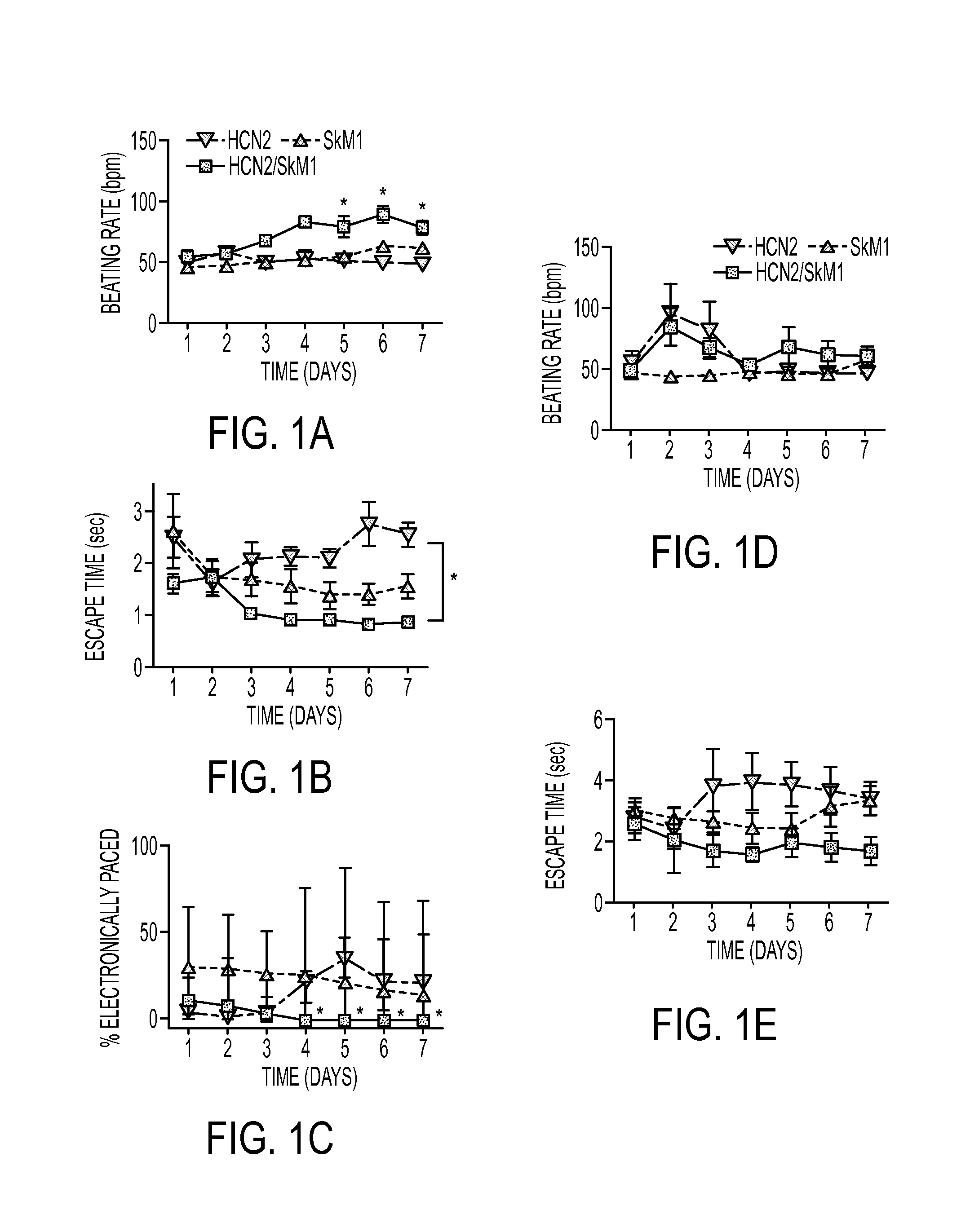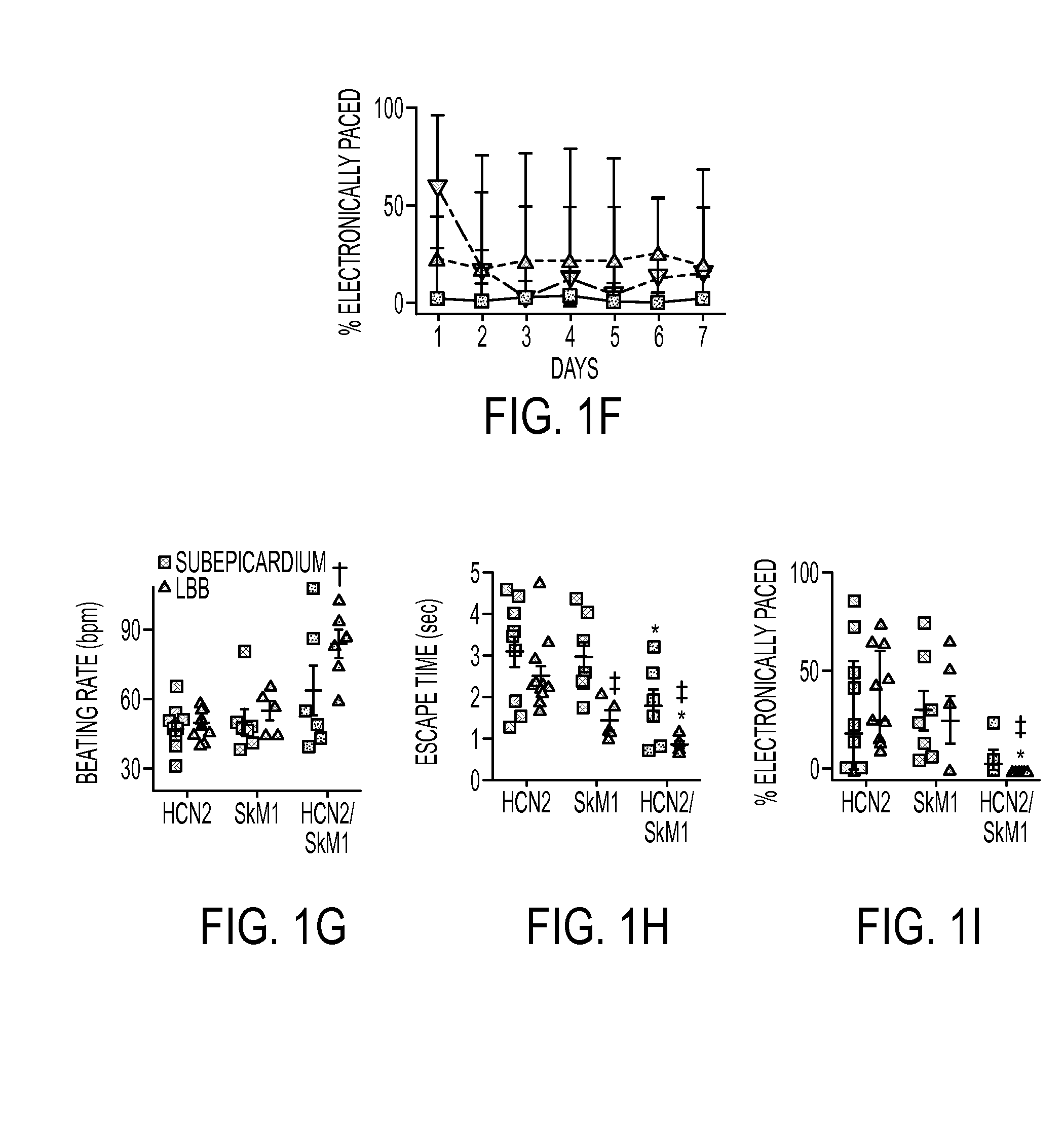Biological Pacemakers Incorporating HCN2 and SkM1 Genes
a technology of skm1 and hcn2, which is applied in the field of biological pacemakers, can solve the problems of serious complications, infection and interference, and the site available for implantation often cannot optimize cardiac contraction
- Summary
- Abstract
- Description
- Claims
- Application Information
AI Technical Summary
Benefits of technology
Problems solved by technology
Method used
Image
Examples
example 1
Overexpression of SkM1 Enhances HCN2-Based Biological Pacemaker Function
[0127]Experiments were performed with the use of protocols approved by the Columbia University Institutional Animal Care and Use Committee and conform to the Guide for the Care and Use of Laboratory Animals (National Institutes of Health publication No. 85-23, revised 1996).
Materials & Methods
Adenoviral Constructs:
[0128]Adenoviral constructs of green fluorescent protein (GFP), mouse HCN2 and rat SkM1, all driven by the CMV promoter, were prepared as described previously. Qu J, Plotnikov A N, Danilo P, et al. Expression and function of a biological pacemaker in canine heart. Circulation 2003; 107:1106-1109; Lau D H, Clausen C, Sosunov E A, et al. Epicardial border zone overexpression of skeletal muscle sodium channel SkM1 normalizes activation, preserves conduction, and suppresses ventricular arrhythmia: an in silico, in vivo, in vitro study. Circulation 2009; 119:19-27. We prepared an empty adenoviral vector as ...
example 2
Results of Intact Animal Studies
Baseline Function
[0141]Biological pacing effectiveness was evaluated in light of baseline heart rates, escape times after overdrive pacing, and percentage time during which the backup electronic pacemaker drove the heart (FIG. 1). These parameters were compared in animals injected with biological pacemakers into the LBB or LV subepicardium. Electrocardiograms (ECGs) were recorded while animals rested quietly on a table (baseline beating rates). Over 7 days, biological pacemaker function in HCN2 / SkM1 LBB-injected animals was superior (i.e., faster basal rates, shorter escape times, and lower percentage of electronically stimulated beats) to that of animals with HCN2 or SkM1 alone, and was superior to that of animals with LV subepicardial injection of HCN2 / SkM1.
Autonomic Modulation
[0142]Sensitivity to autonomic modulation of pace-mapped rhythms was studied via 24-h ECG recordings. Faster beating rates were reached in HCN2 / SkM1 LBB-injected animals than ...
PUM
| Property | Measurement | Unit |
|---|---|---|
| Fraction | aaaaa | aaaaa |
| Electric potential / voltage | aaaaa | aaaaa |
| Body weight | aaaaa | aaaaa |
Abstract
Description
Claims
Application Information
 Login to View More
Login to View More - R&D
- Intellectual Property
- Life Sciences
- Materials
- Tech Scout
- Unparalleled Data Quality
- Higher Quality Content
- 60% Fewer Hallucinations
Browse by: Latest US Patents, China's latest patents, Technical Efficacy Thesaurus, Application Domain, Technology Topic, Popular Technical Reports.
© 2025 PatSnap. All rights reserved.Legal|Privacy policy|Modern Slavery Act Transparency Statement|Sitemap|About US| Contact US: help@patsnap.com



